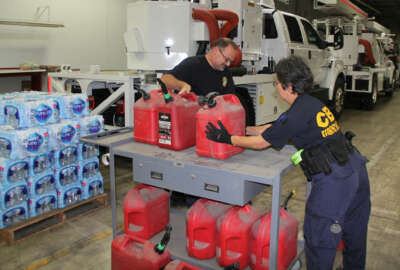Sponsored by Zebra Technologies
NOAA modernizing logistics systems for more streamlined, efficient processes
The modernization efforts will streamline various logistics systems into a single view, while integrating new technologies like barcoding.
With sensors everywhere from the bottom of the ocean to outside Earth’s atmosphere, the National Oceanic and Atmospheric Administration requires a robust logistics system to manage all its moving parts. That’s why Douglas Templeton, chief of the National Logistic Support Center (NLSC) for NOAA and the National Weather Service, said NOAA is currently modernizing its logistics systems. Everything from the software to the business processes to the distribution will be updated.
“They’re older systems. They were purpose built for us in 1989. And a lot of that computer language has changed over the years,” Templeton said on The Modernized Warehouse. “And so we’re in the process of doing a modernization right now where we’re bringing each one of those systems up to a more current software language. They’re Oracle based.”
That modernization should be complete within the next 12 to 18 months, Templeton said. NLSC has already completed upgrades to the Weather Integrated Logistics System, which is the linking mechanism between other agencies and NOAA’s Consolidated Logistics Systems (CLS) suite. Next in line are CLS itself, and a subsystem known as Alpha, which tracks repairable parts through their repair cycle. These upgrades are going to bring significant improvements across the enterprise.
Streamlining, improving logistics systems
For one thing, it will allow employees to view all the various logistics systems and subsystems in a single screen to get a comprehensive view of the logistics process, from requisition to shipment tracking. It will also allow NLSC to integrate newer technologies to further modernize processes. The prime example, Templeton said, is barcoding parts.
“That language has to allow for us to be able to integrate that barcoding software,” he told the Federal Drive with Tom Temin. “Right now when a material handler pulls something off the shelf to ship, he brings it over to the shipping department, and the shipping department has to manually input that data into the system. Whereas with a barcode it’d be a quick scan. And then they would be onboard to basically ship it out in a much faster method.”
That’s important for NLSC, because emergency requisitions have to be shipped out in 24 hours, while routine requisitions have 48 hours. That time savings from barcodes would allow NLSC to achieve its logistics mission more efficiently.
Templeton also said vendors for the products themselves already produce the barcodes on the shipping boxes. That means NLSC isn’t adding any work on their end; they’re just taking advantage of existing elements.
“So we’ve prepped the battlefield, so to speak, with the barcodes already in place, so that when our technology catches up, then we integrate it right into the system,” he said.
Training
Templeton also said this process would be easier for employees and customers; he won’t have to retrain the entire customer base or his employees on a new system. The existing one will simply get more efficient.
And that’s important, because Templeton said NLSC is currently going through a retirement “cycle.” Of the 24 employees that work there, Templeton said the majority have done so for more than 20 years, and a number have either recently retired or are preparing to.
That means Templeton has been managing the knowledge capture process, to ensure that the institutional knowledge absorbed by those long-term employees transfers to their newer replacements. Always a difficult proposition, it would be much more so if NLSC adopted an entirely new set of systems and processes immediately after the new employees spent a year shadowing experienced employees and learning the current ones.
Copyright © 2024 Federal News Network. All rights reserved. This website is not intended for users located within the European Economic Area.
Daisy Thornton is Federal News Network’s digital managing editor. In addition to her editing responsibilities, she covers federal management, workforce and technology issues. She is also the commentary editor; email her your letters to the editor and pitches for contributed bylines.
Follow @dthorntonWFED






